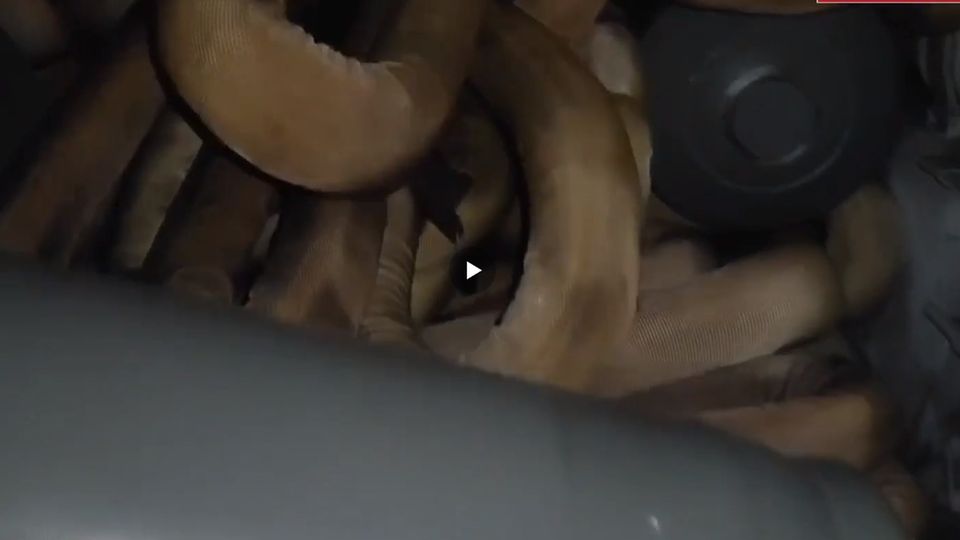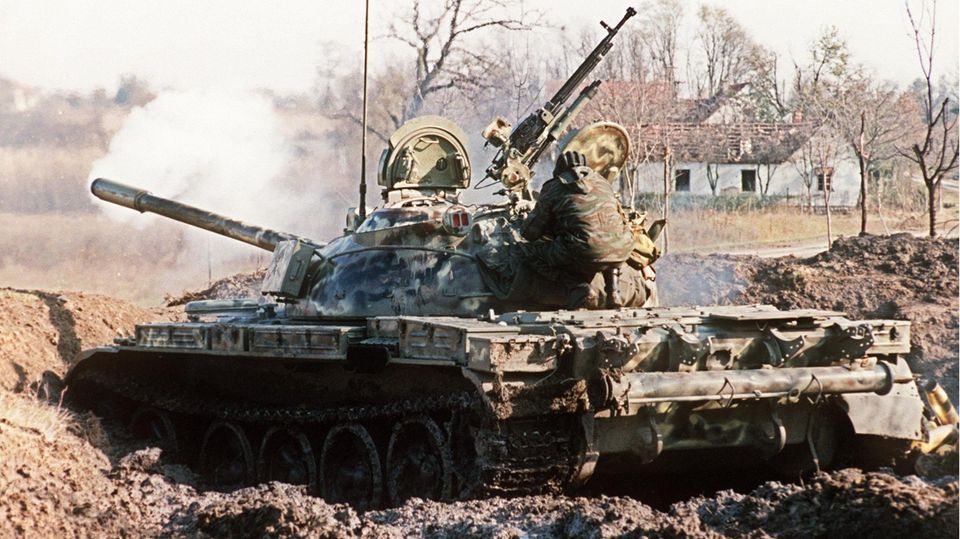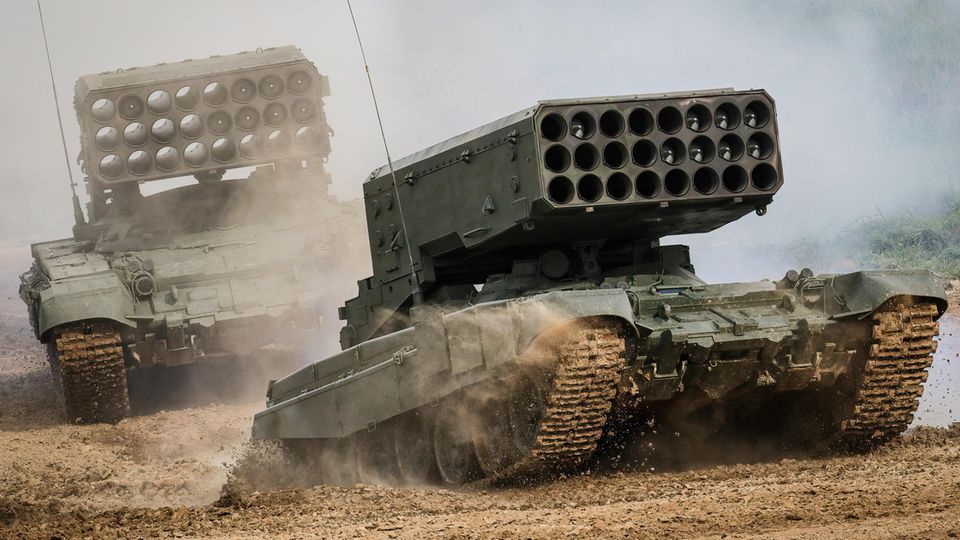With tons of explosives
Putin’s kamikaze tanks – the first sorties of T-55 drones
The explosion of the explosive tank.
© Russian Ministry of Defense / PR
Russia stuffs old tanks with explosives and then rolls them against Ukrainian positions. One attack failed on a mine, but more demolition tanks will be used in the future.
Over the weekend, an old T-54/55 tank rolled towards a Ukrainian position. His target was the Ukrainian trenches in a row of trees south of Marjinka, his task: to blow himself up there.
This technique was made famous by the IS: A vehicle is loaded to the brim with explosives, then the driver’s cabin is protected with improvised armor plates. The driver then tries to reach the opponent’s position to blow himself and the vehicle up. The Russians are apparently adapting this tactic, albeit with remote control of the tank and without suicide drivers. Kamikaze says: The tank blows itself up and not the driver.
At the end of the day, an explosive tank is a kamikaze drone that operates on the ground, not in the air. This is not new, in the Middle Ages burning horse-drawn carriages were used for similar purposes. The former German Wehrmacht developed the Goliath mini tank. He was remotely controlled with wires and crawled towards an enemy position to blow himself up there. It was first used in the Battle of the Kursk Bulge, Operation Citadel. It is not the first parallel between the current fighting and the 1943 battle.
effect by mass
The difference between Goliath and the Russian tank is sheer size. Charges of five tons of explosives and more can be accommodated in an old tank or infantry fighting vehicle – a similar size to the trucks of the IS. If the vehicle reaches its destination, the effect is fatal. The explosion tears a huge hole in every position system, in a wide area the soldiers are injured or killed by the air pressure of the explosion. Others are in shock. When a tank is professionally modified by engineers, it can be expected that they will weaken the armor on the front and sides in order to achieve optimal effect of the explosion. In fact, it is surprising that SVBIED are only now being used in Ukraine. Both sides have large scale old or unserviceable vehicles and the skills to perfect such a rolling bomb.
However, the limits of the concept became apparent when the Russians first used it in space. The tank hit a mine and came to a halt just short of the Ukrainian line. Apparently suspecting a trap, the Ukrainians did not send a squad to examine or recover the tank. They destroyed it with a rocket. This can be seen, among other things, on the pro-Kiev Twitter account Caliber Obscura.
Not an isolated case
It is not an isolated case. An old T-54/55 was prepared near Marjinka, the Russian Ministry of Defense had previously shown the conversion and use of a captured MT-LB armored personnel carrier in a video. The smaller and flat vehicle was prepared by pioneers with 3.5 tons. They made the task easy for themselves and dispensed with any form of remote control. The driver brought the transporter on course in the direction of the enemy, then blocked the gas and steering and jumped out of the vehicle. But it shouldn’t be a problem for Russia to build a remote control set that at least controls speed and steering angle.
Explosive tanks have trouble reaching a heavily fortified position, even though the deployment would be optimized. For example, when the tank advances protected by smoke grenades and accompanied by suppression fire. Explosive tanks, on the other hand, have a good chance if they are left in positions that the friendly side has abandoned or in a counterattack when the enemy has not yet been able to fortify the new position.
Effect like the biggest bombs
The special thing is the strength of the explosion. They can only be compared to the mines of World War I, when tunnels were dug under the enemy’s line and then blown up enormous amounts of explosives at depth. The Russian glide bombs that are currently hitting the Ukrainians are mostly based on a bomb with 500 kilograms of explosives. A tank can transport five to ten tons if it is cleared out beforehand. Bombs with a similar effect are never or only rarely used.
The effect corresponds to the American “mother of all bombs” or the even more powerful “father of all bombs” from Russia. There is currently a fierce struggle over small villages. If such a charge is optimally prepared, its explosion would flatten the entire village and kill the defenders.
Expert assumes increased effort
Mick Ryan, a former Australian major general who regularly comments on the war, puts the deployment in this way. He uses the correct abbreviation UCV – unmanned combat vehicle.
“It is interesting that after flooding the battlefield in Ukraine with thousands of autonomous aerial vehicles, the Russians are now deploying ground-based unmanned combat vehicles.
And while they’re slow and easy to hit, with so much explosive they don’t need to get very close to Ukrainian forces to cause death or destruction. The Russians will certainly continue to test this approach and learn from it.
The deployment of UGVs on the battlefield in #Ukraine is another aspect of tactical #customization that we should be watching. The use of unmanned vehicles, particularly in high-risk ground operations, is sure to increase.”

The Russians show the explosive landings on board the converted transporter.
© Russian Ministry of Defense / PR
Entire villages are leveled
The use of massive firepower is crucial in this form of warfare. Over the weekend, the Ukrainians managed to capture the small settlement of Pjatychatky, which had been fought over for days. But apparently the Russians were prepared for the loss. They are said to have provided several TOS 1A heavy flamethrowers and claim to have showered the small settlement and Ukrainian crew with over 100 thermobaric missiles. The result can be seen on videos: The place no longer exists. SVBIED can be manufactured “on the assembly line” from the vast quantities of old T-54 tanks and similar devices. They could be parked in a shed near the front and used in a critical situation.




